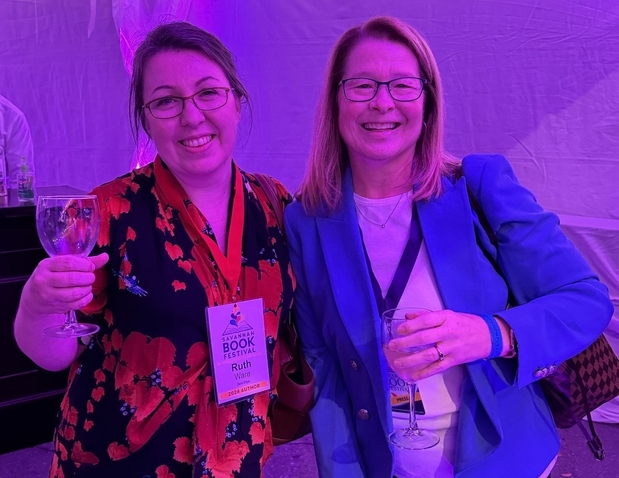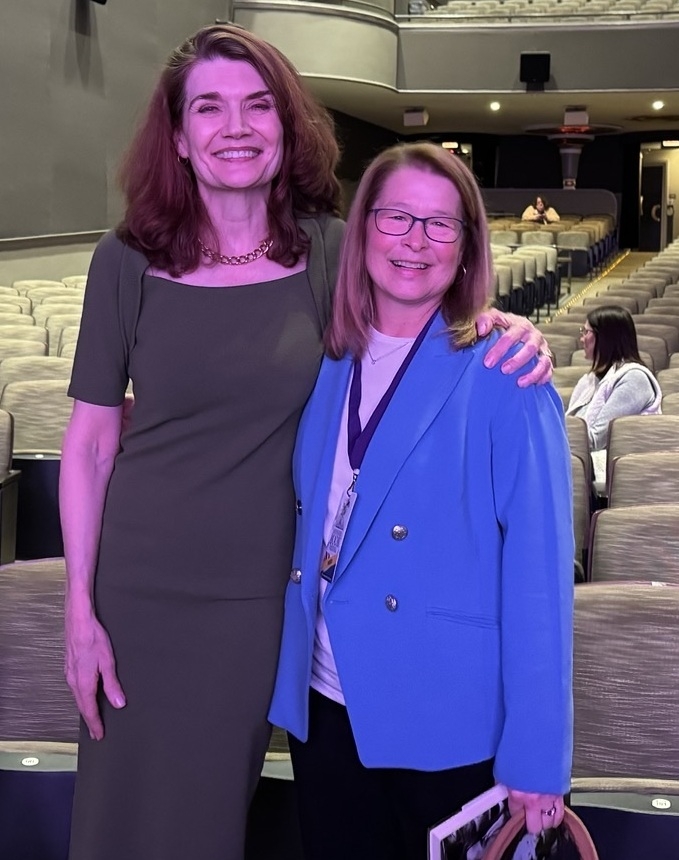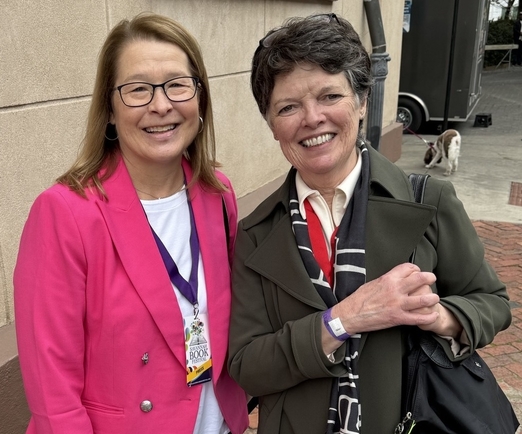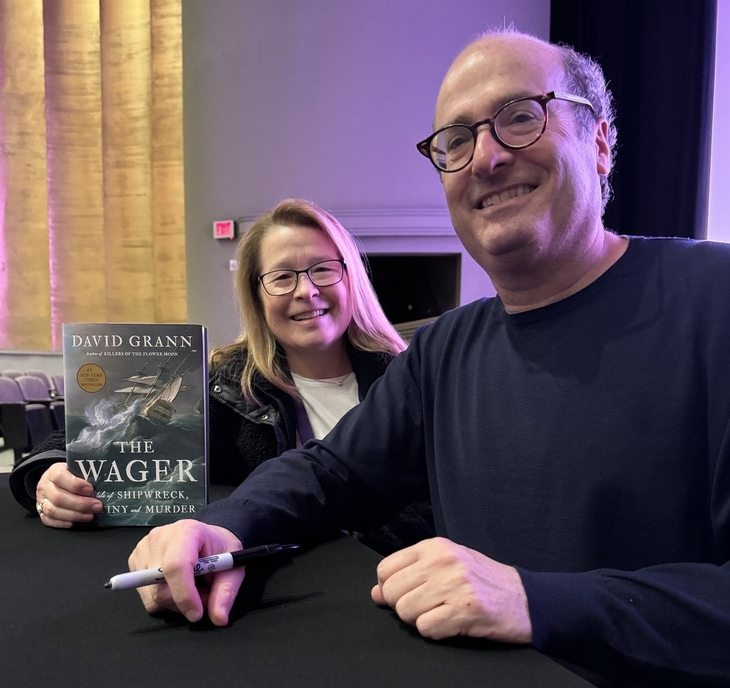The 17th annual Savannah Book Festival took place on February 15-18 centered on Telfair Square and six different venues in the downtown historic district. Thirty-plus authors were in attendance, 22 of whom arrived early to participate in SBF@Schools, a program that gives authors the chance to visit schools in the area to promote a love of reading and writing.
 Thursday’s Opening Address
Thursday’s Opening Address
New York Times bestselling author Ruth Ware, whose latest book is ZERO DAYS, opened the event Thursday night. She delivered an inspirational speech to a packed house that seats 1,100 on how staying home with her children led her to write her first novel. I caught up with Ruth later and told her, “Carol Fitzgerald from Bookreporter will never forgive me if I don’t say hello to you!” Her face lit up as she remembered being interviewed by Carol prior to the publication of her debut, IN A DARK, DARK WOOD.
 Friday’s Keynote Address
Friday’s Keynote Address
The Keynote Address was delivered Friday evening by Jeannette Walls to a sold-out crowd. Walls is best known for her instant New York Times bestseller THE GLASS CASTLE, and her latest novel is HANG THE MOON. Walls emphasized how important it is to own your story, stating, "Use your story instead of your story using you," which gave her the courage to move forward in life. When she was 10 years old, she read A TREE GROWS IN BROOKLYN by Betty Smith. This began her lifelong love of reading and storytelling, which helped her endure her tumultuous childhood. What really touched me was one of her last comments when speaking about her mother, who saved everything: “Hoarders see the beauty in everything.”
Free Festival Saturday
I began my Festival Saturday with the plan of hearing John Berendt speak about his classic novel, MIDNIGHT IN THE GARDEN OF GOOD AND EVIL, which was published 30 years ago. This being my first Savannah Book Festival, I wasn’t aware that you typically have to arrive at venues 45 minutes to an hour in advance to secure a seat. I arrived 15 minutes early and was not able to attend. Such is the plight of a first-time attendee.
Luckily, one of our longtime readers, Nancy Bader, was there. Here’s her commentary on that program.
From Nancy Bader...
John Berendt said that one reviewer had called MIDNIGHT IN THE GARDEN OF GOOD AND EVIL “a love letter to Savannah, and that's how I feel.” He said that Savannahians were willing to talk to him because they didn't believe he was actually going to write a book. During the years he lived off and on in Savannah, he kept a notebook in his back pocket to take notes. People would sit down with him to talk about other people, and those people sat down to talk about the first ones. “How Savannahians communicate is they tell stories. A Northerner will say ‘Mrs. Jones put on her coat.’ A Southerner will say, ‘Mrs. Jones put on her coat, given to her by her third husband before he committed suicide.’”
All the characters in the book are either real or based on real people. “I wrote about the eccentrics because they were more fun to write about.” His first agent nixed the book as being “too gossipy.” Instead of re-writing, Berendt got a new agent. The result: a book that still holds the record for the longest time on the New York Times bestseller list --- 216 weeks.
His advice to would-be writers: “Make sure your prose has rhythm. The reader will know if the rhythm isn't right.” How did he do it? From Savannah, he would call his answering machine at his New York apartment (remember, this was 30 years ago) and dictate whatever he had written. Then he would call back, play the message, and listen to how it sounded.
The 30th anniversary edition of MIDNIGHT IN THE GARDEN OF GOOD AND EVIL, with a new foreword from Berendt, recently released, and a musical will be opening in Chicago soon.
I had the pleasure of hearing S. A. Cosby talk about his latest novel, the instant New York Times bestseller ALL THE SINNERS BLEED. He spoke of his journey to become a writer, working at Lowe's full time while continuing to write short stories with no success. Then he was offered a management position. Thankfully, for all of us readers, his boss told him that if he accepted the job, he would never write. Cosby took that advice to heart and turned down the promotion. At the time, his girlfriend, Kimberly (now his wife), had a friend who was a dancer in New York City and was friendly with a bartender. The bartender was Todd Robinson, the creator of the short fiction magazine Thuglit. Cosby went to New York City to meet Todd and began writing short crime stories for $100. After a year and a half, Todd convinced him to write a book.
 Next up was Alice McDermott. I recently devoured her latest novel, ABSOLUTION, which takes place just before the outbreak of the 1963 war in Saigon. McDermott explained that the book asks the question: “What do you sacrifice to do something good for someone else?” Told through female relationships and conversations outside of their husbands, her characters --- Navy engineer wives stationed in Saigon --- answer the question.
Next up was Alice McDermott. I recently devoured her latest novel, ABSOLUTION, which takes place just before the outbreak of the 1963 war in Saigon. McDermott explained that the book asks the question: “What do you sacrifice to do something good for someone else?” Told through female relationships and conversations outside of their husbands, her characters --- Navy engineer wives stationed in Saigon --- answer the question.
McDermott spoke freely, filled with beautiful prose, just like she writes. When asked where the idea for ABSOLUTION came from, she said, “I was sitting on a panel at the 92nd Street Y in New York City, next to Elie Wiesel, who knows how a novel gets written!” She went on to explain the genesis of two parallel thoughts she had. The first occurred when she was an English major undergrad at SUNY Oswego. She was assigned to read Graham Greene’s novel, THE QUIET AMERICAN, and how his drive back to Saigon from the Ben Tre province predicted the debacle of 1950s Saigon.
The second thought came from the women she had come across in Washington, DC, who had led interesting lives in the 1950s and ’60s. Many were spouses of military men, from the CIA to diplomats, and were not uncomplicated humans. She remembered watching a grandmother reading to a group of children at a library and then folding napkins into different origami shapes. McDermott asked her how she learned to do this, and she replied, “When I was living in Burma.” McDermott told us, “You had to ask. They didn’t offer up anything about their lives. I wanted to give voice to these women.” She then shared a childhood memory of her mother taking her to play Barbies with another girl who didn’t have much. That girl had a Barbie dressed in an áo dài. Hence, the making of the áo dài doll clothes in ABSOLUTION.
Lastly, a reader asked how McDermott came up with the book’s title. She had gone to dinner with a friend who was a retired priest. When he asked what the title would be, she said, “Absolution.” He responded that it was an awful name: “The definition of absolution is to set free. It is not a solitary act. It involves two people with the basic instruction of, ‘I absolve you and I seek your absolution.’” McDermott explained the Gospel of John: “No greater love than to lay down your life for a friend.” The priest replied, “You’re absolved.” The audience erupted in laughter.
Amy Kurzweil was next on my schedule. A graphic novelist and cartoonist, Kurzweil is the author of ARTIFICIAL. Using single-panel cartoons, she told her story through PowerPoint slides, including some of the cartoons she had created for The New Yorker. Her idea for the book came out of curiosity: “What would using digital technology to tell a story look like, and what will it do for art in the future?”
Kurzweil spent months helping her father, Ray, collect and digitize documents from his deceased father, Fred, for the chatbot Ray created. She realized the impact of three generations of creators in her family and how it could be preserved. She shared with the audience how Fred’s life was saved because he was an accomplished pianist from Vienna and was able to flee the Nazis in 1938 due to the help of a sponsorship to America. ARTIFICIAL, Kurzweil’s second graphic novel, tells the story of her family’s three generations of creators. At the end, she answered her own question: “The human hand plays a significant role in preserving history. AI is created by human hands. AI is an art, to preserve history.” We’ve all read the negative impacts of AI. It was enlightening to hear the positive.
Then I heard Alex Prud’homme speak about his latest book, DINNER WITH THE PRESIDENT: Food, Politics, and a History of Breaking Bread at the White House. He began his slide presentation with photographs of different presidents, the dinners and their meaningful impacts. Prud’homme decided to delay college for a year and travel. He ended up traveling for several years and kept a journal. When he returned home, he began writing short articles as a freelancer. One of those pieces, “Slave,” became what we now know as Seinfeld’s Soup Nazi. Prud’homme’s grandfather was the twin brother of Julia Child’s husband, Paul. Stories were told around the dinner table, and eventually he spent months with Julia co-writing her memoir, MY LIFE IN FRANCE. One of the slides shown was a photo of Prud’homme with Julia just one day before her death at the age of 91.
Prud’homme participated in the documentary Julia and consulted on the HBO series of the same name. When he came across Julia on the red carpet at a White House state dinner, he became curious and wanted to know more about White House dinners, which led to his writing DINNER WITH THE PRESIDENT. Through his research, Prud’homme learned that conversations over food can elicit helpful information. As he quipped, “When you’re the President, every bite counts.” He also said, “Scientifically, a communal evening reinforces endorphins” and “food may not be the answer to peace, but it's a start.” Prud’homme explained how important the role of a president’s wife is in planning dinners, both big and small, regardless of the guest list. Some take it very seriously and are instrumental in the decisions. Others don’t cook and have no interest in the planning. It had me wondering how this will be handled when our country elects a female president.
During the Q&A, an attendee asked, “If you could, what dinner do you wish you’d been able to attend?” Prud’homme said, “I’d choose the dinner at Mt. Vernon with the Kennedys.” On my way out, I passed by where Prud’homme was standing and asked, “Were any presidents good cooks?” He said, “President Eisenhower and President Carter were, and they both enjoyed hunting and fishing.”
Next up was James L. Swanson, the Edgar Award–winning author of the New York Times bestseller MANHUNT: The 12-Day Chase for Lincoln’s Killer and an executive producer of the 2024 Apple TV+ series, "Manhunt." He spoke about his latest book, THE DEERFIELD MASSACRE: A Surprise Attack, a Forced March, and the Fight for Survival in Early America. His fascination with history began as a child when his grandmother gave him a peculiar gift: a newspaper clipping on John Wilkes Booth and the assassination of Lincoln. Unfortunately, it was torn. Swanson wanted to read more, so he began his lifelong desire to understand history.
In 1704, during the time of Queen Anne’s war on who was going to take over the world, colonists enlisted natives to attack the people of Deerfield, MA while they slept in their beds. One of the homes attacked was owned by John Sheldon. The front door was designed to survive the New England cold winters and the heat of the summer. It is one of the lasting relics from the Deerfield Massacre. You can see where the attackers attempted to cut through the door with axes in order to gain entrance to the house before the natives and French colonists broke through the back door.
Having just seen the movie based on the book, KILLERS OF THE FLOWER MOON: The Osage Murders and the Birth of the FBI by David Grann, I had no idea that natives previously had joined forces with early colonists slaughtering whole families, including children, and kidnapping those who would be useful to them. I love history, and it was a pleasure to listen to Swanson.
Fun fact: Swanson was at the National Book Foundation and met Matt Prickett in 2008 while giving a talk on his book, CHASING LINCOLN’S KILLER. Matt said he was starting a book festival in Savannah, GA and asked if Swanson would like to be one of the speakers.
This year featured two new panel discussions: Historical Fiction and Thrilling Fiction. The Historical Fiction panel featured Lauren Grodstein, the New York Times bestselling author of WE MUST NOT THINK OF OURSELVES, a “Read with Jenna” pick; Susan Meissner, the USA Today bestselling author of ONLY THE BEAUTIFUL; and Theodore Wheeler, the literary noir author of THE WAR BEGINS IN PARIS.
The Thrilling Fiction panel featured the aforementioned S. A. Cosby; Gregg Hurwitz, author of the New York Times bestselling Orphan X thriller series, the latest of which is LONE WOLF; and Charles Soule, the bestselling author of THE ORACLE YEAR, ANYONE and his most recent novel, THE ENDLESS VESSEL. I did not attend either of these panels, but word on the street suggested they were a hit.
 The festival’s closing address featured the aforementioned #1 New York Times bestselling and Edgar Award-winning author David Grann, whose latest book is THE WAGER: A Tale of Shipwreck, Mutiny and Murder. Grann shared how he grew up by the sea as his father was a sailor. He had read John Byron’s journal and was inspired by the competing journals on the internet over the British mutiny, which led to his decision to visit Wager Island, “a place where the soul of a man dies.” He felt it was a story from the past that we could see fuller now. Having taken a year to learn how to read the shipmen’s journals from naval historians, who taught him the language used in the 1700s, he knew this story needed to be told.
The festival’s closing address featured the aforementioned #1 New York Times bestselling and Edgar Award-winning author David Grann, whose latest book is THE WAGER: A Tale of Shipwreck, Mutiny and Murder. Grann shared how he grew up by the sea as his father was a sailor. He had read John Byron’s journal and was inspired by the competing journals on the internet over the British mutiny, which led to his decision to visit Wager Island, “a place where the soul of a man dies.” He felt it was a story from the past that we could see fuller now. Having taken a year to learn how to read the shipmen’s journals from naval historians, who taught him the language used in the 1700s, he knew this story needed to be told.
Grann spoke for about 30 minutes with a slide show displaying his trip to Wager Island. He had found a captain, and the boat looked sizable enough to travel the coast of Patagonia, also known to sailors as the Gulf of Pain. When he arrived, he was surprised by how small the wood-heated boat was. Unfortunately, he was quite seasick and took everything in his arsenal to combat it. He shared video of the boat making its way through large, treacherous waves, as well as pictures of him wearing his orange life vest, North Face winter gray hat and waterproof seafaring jacket touring Wager Island. There he found the celery that the seaman lived on was still growing on the island, along with remnants of the Wager in the water resting on the sand.
“Just as people tell their stories to preserve their history, so do nations.” Grann spoke about John Duff, a black seaman who couldn’t tell his story because he was kidnapped and sold into slavery. His silence tells his story. Grann then shared, “All writers, in some respects, like to explore human behavior. Wager Island will always be a laboratory to me.”
During the Q&A, one attendee asked, “Out of the main characters in THE WAGER, who did you most identify with?” He answered, “John Byron.” Then he went on to say, “Writing THE WAGER felt like a parable in our current troubling times.” When asked by another audience member, “What role do you think you would play had you been on the ship?” he quickly commented that he’d probably be one of the deserters. Then he thought for a minute and said, “It’s hard to know what one would do in that situation. I’m not sure.” Lastly, Grann was asked what he’s working on next. He replied, “Espionage, but I worry I’ll be shipwrecked on an island like the Wager.”
We read and discussed THE WAGER for one of the book clubs I co-moderate, so it was nice to get my book signed and thank him for his story.
 One non-bookish but fun thing: All ticketed events are held at the Trustees Theatre on Broughton St. next door to Leopold's Ice Cream. Leopold’s renamed their flavors for each of the authors. After watching the line for ice cream grow longer each night, I finally indulged. I enjoyed a small cup of How to Sell a Chocolate House, renamed for Grady Hendrix’s HOW TO SELL A HAUNTED HOUSE. It was delicious and worth the wait in line!
One non-bookish but fun thing: All ticketed events are held at the Trustees Theatre on Broughton St. next door to Leopold's Ice Cream. Leopold’s renamed their flavors for each of the authors. After watching the line for ice cream grow longer each night, I finally indulged. I enjoyed a small cup of How to Sell a Chocolate House, renamed for Grady Hendrix’s HOW TO SELL A HAUNTED HOUSE. It was delicious and worth the wait in line!
Telfair Square --- where festival goers could indulge in southern cuisine from several local food trucks, purchase books at the book tent and have them signed by the authors --- was busy throughout the festival.
The festival was well-attended, and I enjoyed every moment. I came home having learned history I was unaware of, I heard new authors and stories I’d never come across, and I met other passionate readers --- including a sister duo who travel to the festival each year, a mother-daughter team from the same neighborhood where my friends are from, and one of the directors from the University of Georgia Libraries. As festival weekends go, I give it an A+ and look forward to attending again next year.


